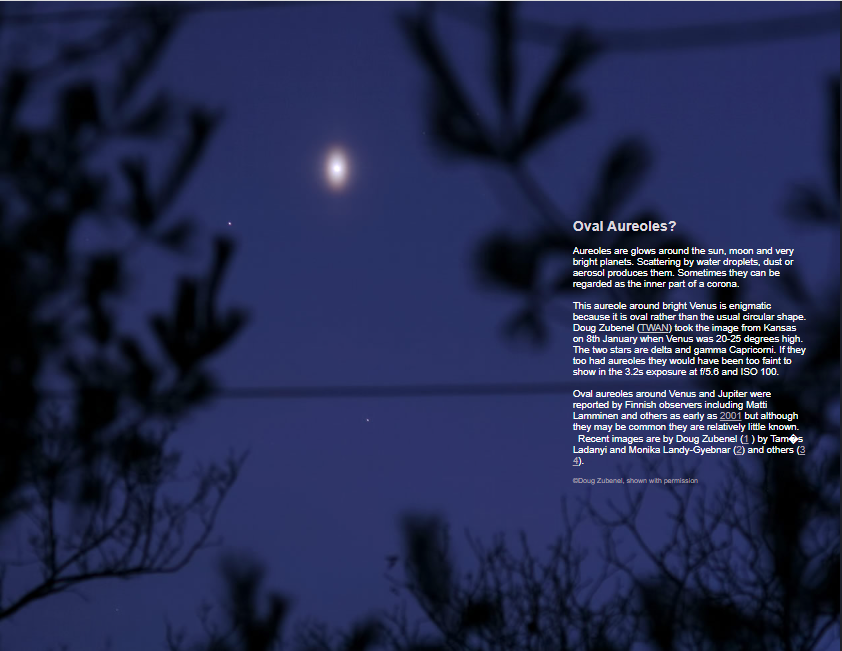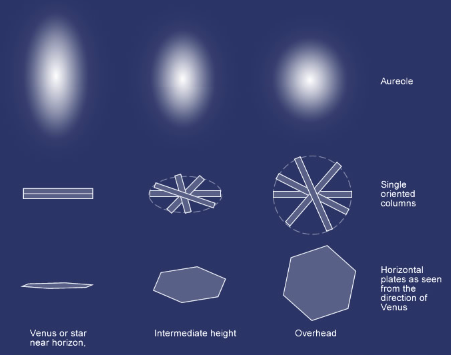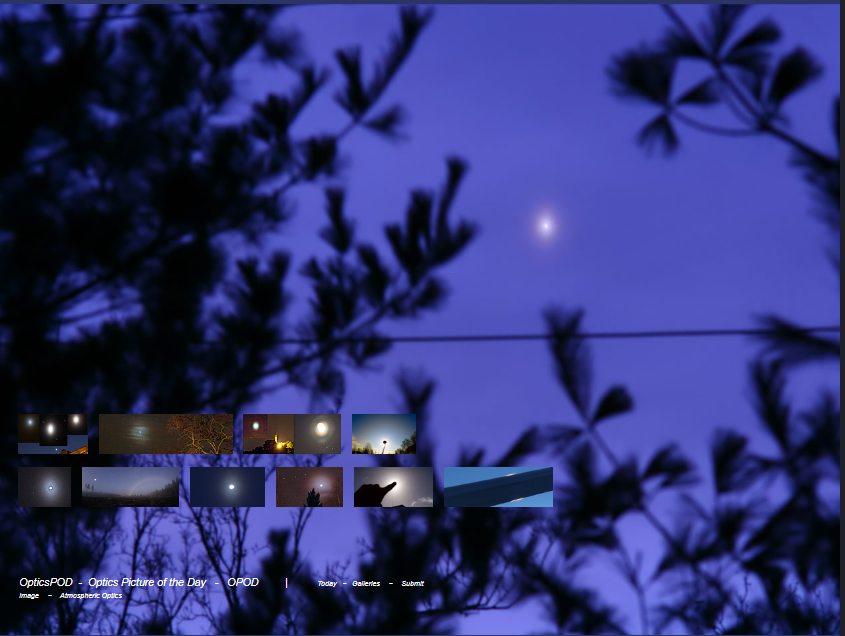OPOD - Oval Venus Aureoles
OPOD - Oval Venus Aureoles: A Mystifying Atmospheric Phenomenon
Aureoles, which are luminous glows encircling celestial bodies like the sun, moon, and bright planets, are commonly observed atmospheric optics phenomena. These ethereal glows are produced through the scattering of light by water droplets, dust particles, or aerosols in the atmosphere. While typically circular in shape, there have been intriguing instances where the aureole around Venus appears as an oval rather than the expected circular form.
This peculiar oval aureole around Venus has captivated the attention of sky observers and photographers alike. The phenomenon was first reported by Finnish observers, including Matti Lamminen, as early as 2001. However, despite potentially being a common occurrence, oval aureoles around Venus remain relatively unknown to the general public. Recent images captured by talented individuals such as Doug Zubenel, Tam�s Ladanyi, Monika Landy-Gyebnar, and others have shed further light on this captivating phenomenon.
One possible explanation for the oval shape of these aureoles is light scattering from horizontally elongated objects in the atmosphere. When light interacts with horizontally aligned hexagonal ice plate crystals or horizontal column crystals present in clouds, it produces a vertically elongated diffraction pattern. This elongation effect may be responsible for the distinctive oval appearance of the aureole surrounding Venus.
By analyzing images captured by Doug Zubenel, we can estimate the approximate size of the oval aureole to be around 0.21 x 0.35 degrees. Using an IRIS simulation, it has been determined that scatterers with a diameter of approximately 0.25mm are capable of creating such an aureole. These dimensions align well with the orientation capabilities of ice crystals within the atmosphere.
Furthermore, the elongation of the aureole is expected to vary depending on the height of Venus above the horizon. When Venus is directly overhead, plate crystals would produce an almost circular profile, resulting in a circular aureole. On the other hand, column crystals, which occupy all azimuthal orientations, would also generate an averaged circular aureole. Thus, a higher position of Venus in the sky would yield a less elongated aureole compared to when it is closer to the horizon.
To validate these theories and gain a deeper understanding of the oval aureoles around Venus, simultaneous observations of halos or near-simultaneous images of aureoles around both low and high bright stars are required. However, conducting such studies poses numerous challenges due to the ever-changing atmospheric conditions that occur minute by minute. Doug Zubenel's lower image, captured merely eight minutes prior to the upper one, demonstrates a significant reduction in elongation. It is worth noting that Venus and Jupiter do not consistently exhibit elongated aureoles, as they can also be circular when created by water droplets.
The absence of oval aureoles around the moon raises interesting questions. While it is theoretically possible for the moon to have aureoles of this nature, they would need to be significantly larger to be visible. This implies the presence of smaller crystals with reduced orientation capabilities.
In conclusion, the oval aureoles surrounding Venus continue to intrigue both scientists and photographers alike. These enigmatic atmospheric phenomena are believed to arise from the scattering of light by horizontally elongated ice crystals or column crystals present in the atmosphere. While further research and observations are necessary to fully comprehend the intricacies of these oval aureoles, they represent an exciting challenge for sky enthusiasts seeking to capture the beauty and mystery of our celestial surroundings.

Oval Aureoles?
Aureoles are glows around the sun, moon and very bright planets. Scattering by water droplets, dust or aerosol produces them. Sometimes they can be regarded as the inner part of a corona.
This aureole around bright Venus is enigmatic because it is oval rather than the usual circular shape. Doug Zubenel (TWAN) took the image from Kansas on 8th January when Venus was 20-25 degrees high. The two stars are delta and gamma Capricorni. If they too had aureoles they would have been too faint to show in the 3.2s exposure at f/5.6 and ISO 100.
Oval aureoles around Venus and Jupiter were reported by Finnish observers including Matti Lamminen and others as early as 2001 but although they may be common they are relatively little known. Recent images are by Doug Zubenel (1 ) by Tam�s Ladanyi and Monika Landy-Gyebnar (2) and others (3 4).
©Doug Zubenel, shown with permission

Oval aureoles could be produced by light scattering from horizontally elongated objects, horizontal elongation gives a vertically elongated diffraction pattern.
Hexagonal ice plate crystals fit the bill because they are horizontally aligned in clouds.. Horizontal column crystals are another possibility. The stars in Doug�s picture allow us to estimate the aureole size as ~ 0.21 x 0.35�. An IRIS simulation then shows that scatterers of about 0.25mm across created the aureole. Ice crystals of that dimension can be well oriented.
If oriented ice crystals are responsible then the aureole elongation should depend on Venus's height above the horizon. For example, if Venus were overhead then plate crystals would have an almost circular profile and give a circular aureole. Column crystals would also give an averaged circular aureole because the columns take up all azimuthal orientations. A high Venus should give a less elongated aureole than a low one.
To help prove the above we need simultaneous halo observations or better, near simultaneous images of aureoles around low and high bright stars. None of this is easy and is complicated by minute to minute changes in atmospheric conditions. Doug�s lower image taken 8 minutes before the upper one shows much less elongation. Nor do Venus or Jupiter always show elongated aureoles � when they are created by water droplets they are circular.
A challenge for photographers!
Why not ovals around the moon? The aureole would have to be large to be visible. That implies smaller crystals. Small crystals are less oriented.

Note: this article has been automatically converted from the old site and may not appear as intended. You can find the original article here.
Reference Atmospheric Optics
If you use any of the definitions, information, or data presented on Atmospheric Optics, please copy the link or reference below to properly credit us as the reference source. Thank you!
-
<a href="https://atoptics.co.uk/blog/opod-oval-venus-aureoles/">OPOD - Oval Venus Aureoles</a>
-
"OPOD - Oval Venus Aureoles". Atmospheric Optics. Accessed on April 19, 2024. https://atoptics.co.uk/blog/opod-oval-venus-aureoles/.
-
"OPOD - Oval Venus Aureoles". Atmospheric Optics, https://atoptics.co.uk/blog/opod-oval-venus-aureoles/. Accessed 19 April, 2024
-
OPOD - Oval Venus Aureoles. Atmospheric Optics. Retrieved from https://atoptics.co.uk/blog/opod-oval-venus-aureoles/.